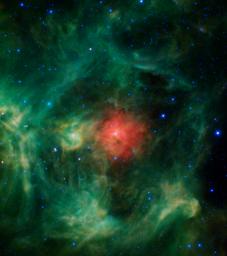NASA's Wide-field Infrared Survey Explorer (WISE) mission presents the "Wreath nebula." Though this isn't the nebula's official name (it's actually called Barnard 3, or IRAS Ring G159.6-18.5), one might picture a wreath in these bright green and red dust clouds -- a ring of evergreens donned with a festive red bow, a jaunty sprig of holly, and silver bells throughout. Interstellar clouds like these are stellar nurseries, places where baby stars are being born.
The green ring (evergreen) is made of tiny particles of warm dust whose composition is very similar to smog found here on Earth. The red cloud (bow) in the middle is probably made of dust that is more metallic and cooler than the surrounding regions. The bright star in the middle of the red cloud, called HD 278942, is so luminous that it is likely what is causing most of the surrounding ring to glow. In fact its powerful stellar winds are what cleared out the surrounding warm dust and created the ring-shaped feature in the first place. The bright greenish-yellow region left of center (holly) is similar to the ring, though more dense. The bluish-white stars (silver bells) scattered throughout are stars located both in front of, and behind, the nebula.
Regions similar to this nebula are found near the band of the Milky Way galaxy in the night sky. The "wreath" is slightly off this band, near the boundary between the constellations of Perseus and Taurus, but at a relatively close distance of only about 1,000 light-years, the cloud is a still part of our Milky Way.
The colors used in this image represent specific wavelengths of infrared light. Blue and cyan (blue-green) represent light emitted at wavelengths of 3.4 and 4.6 microns, which is predominantly from stars. Green and red represent light from 12 and 22 microns, respectively, which is mostly emitted by dust.
JPL manages the Wide-field Infrared Survey Explorer for NASA's Science Mission Directorate, Washington. The principal investigator, Edward Wright, is at UCLA. The mission was competitively selected under NASA's Explorers Program managed by the Goddard Space Flight Center, Greenbelt, Md. The science instrument was built by the Space Dynamics Laboratory, Logan, Utah, and the spacecraft was built by Ball Aerospace & Technologies Corp., Boulder, Colo. Science operations and data processing take place at the Infrared Processing and Analysis Center at the California Institute of Technology in Pasadena. Caltech manages JPL for NASA.
More information is online at http://www.nasa.gov/wise and http://wise.astro.ucla.edu.

 Planetary Data System
Planetary Data System












